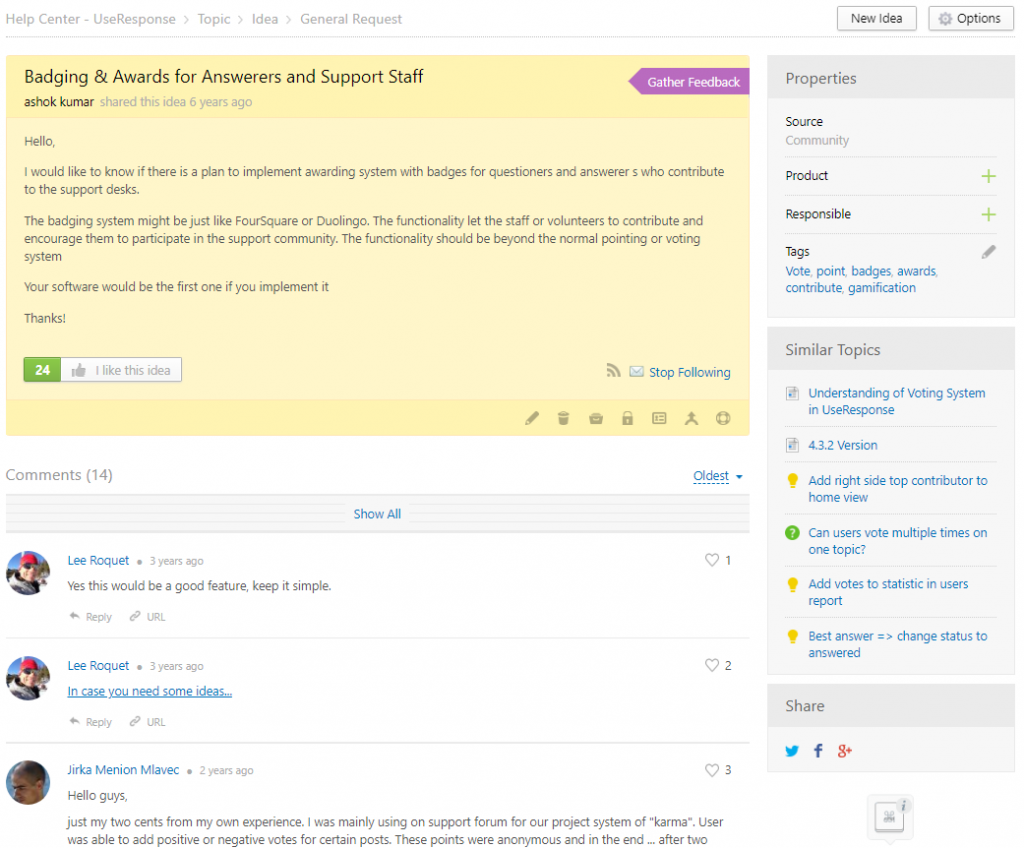Getting feedback in the early stages of your business is extremely important. That’s because you don’t have much room to fail. Your team is small and you are operating on a limited budget. Therefore you have limited time to learn what works, what doesn’t, and what you should really focus on.

If something doesn’t contribute to your growth, you should get rid of it. And once you’ve discovered something that people really like, you need to double down your efforts into making that even better.
From the very beginning, your focus should be on building a better product, getting more sales, and retaining the customers.
Use Customers Feedback to understand:
- Which features to improve
The real knowledge about your product will come after your customers start using it for the first time. At this stage, they’ll be able to tell you what features are good, bad, and how you can improve it.
By getting insights into how to meet customers’ expectations, solve their problems, and fulfill their most desired needs, you can build a product around what they really want.
This doesn’t mean you should implement each client request. Filter them, analyze, estimate the ROI and only after that bring the customer idea into life.
2. Which pricing model to choose
When you take into consideration the cost of rent, taxes, development resources, marketing, etc., you realize that pricing can make or break your business. From the customer’s perspective, some may want to month-to-month plans instead of yearly. Meanwhile, others may prefer to pay a higher price for the premium experience. That’s why pricing is such a sensitive topic.
You need to take into strike the balance between how much your competitors charge and how much your potential customers are ready to pay, how will they estimate the value your product will bring to them.
3. How satisfied your customers are
It costs a way more to acquire a new customer than to retain the ones you already have. And for most startups, every dollar matters. That’s why you need to create the best possible experience for your customers if you want them to stay loyal to your brand.
Customer feedback helps you determine if your clients are truly satisfied and which areas you need to improve. By offering to solve their problems, you build value and strengthen your relationship. This helps to retain them in the long-run.
How to collect feedback
There are lots of people and places online and offline to get feedback and advice for startups, even if you don’t live in a big tech hub. Let us give you some tips on getting feedback when launching a startup.
1. Start Small
Start by asking for feedback from your colleagues, friends, and family, better someone who is close to your target audience. Or better find your potential customers and talk to them directly.
Forums are a great place to start finding your potential customers and talking to them directly. Try searching for local and online startup meetups to meet in person and online.
You can also try using these specialized platforms to get some initial feedback at the beginning of your startup journey:
- BetaList – community of makers and early adopters to exchange feedback
- One MillionbyOne Million round tables to get advice and feedback
- Clarity – on demand business advice from experts
- Community of tech lovers and early adopters
- Ask for users opinions on Quora
- Reddit communities like /r/startups/ , /r/mutualcollaboration/, /r/SideProject/
- Facebook groups like SaaS Growth Hackers
- Linkedin groups (STARTUP SPECIALISTS GROUP, Band of Entrepreneurs , Entrepreneurs Meet Investors )
2. Grow your feedback
We advise you to use usability tests, surveys, customer interviews and live chat as part of your feedback system. That’s because, with these channels, you can start conversations and receive in-depth responses with relative ease. Don’t wait for your customers to reach out to you, you should be the first to initiate the dialogue.
Check out the list of other possible 10 feedback channels you can use.
3. Keep it easy
When customers are satisfied, they rarely go out of their way to provide feedback. That’s why you need to take a proactive approach and go to them first. Surveys are a great way to do just that. By sending a customer a short feedback survey or at least NSP at different checkpoints (such as immediately after purchase, after customer service experience, or a few weeks after the sale), you’ll make it easy for them to give you their much-needed feedback.
4. Respond to everything
Most entrepreneurs want to ignore negative responses, but every piece of feedback you receive, whether positive or negative, will serve as a foundation for the improvements you make within your business.
Talk to your customers every day. Learn their goals, what they are trying to achieve, what difficulties they come across, in order to understand what is stopping them from achieving their goals with your product. You should also ask what they like about your product and what you could be doing better.
5. Put all the feedback in one place
With so many channels available, it’s easy to lose track of data if you rely on spreadsheets or emails only. In the beginning, you’ll be able to manage all your feedback with Trello boards or simple spreadsheets.
But as your feedback grows, we recommend you using feedback software to organize it into one place. Feedback software allows you to gather all the incoming requests (emails, social media mentions, chat messages, website form messages, app ratings and reviews) in one place. This way you can easily analyze the data and build your product roadmaps.
6. Focus on quality instead of quantity
The core thing you need to understand is the pain points and problems of your customers and see if your product will really help them to solve the challenges they have.
To grow a business, you have to stop losing your customers. In order to stop the churn, you need to know the exact reasons why your customers are leaving. To know these reasons, all you need to do is talk to them. All the statistic data you receive in your analytics tools won’t tell you why your customers are unhappy, and this is not a guessing game.
How to get feedback when your business matures
As your business grows, you won’t have time to do in-depth research with each customer. Here’s what we recommend during this stage of the process.

1. Focus on the scale. You need to be able to gather hundreds (if not thousands) of pieces of data from customers. That’s why we recommend using specialized tools such as in-app feedback. Thanks to automations, triggers and sometimes smart AI they allow you to collect and analyze massive amount of data without any extra time and effort on your part.
A beautiful tool to use when you have at least a growing database of users is a community feedback portal – a crowd-sourcing platform that meets real-time feature requests with customer demand-based voting.

2. Track customers’ feedback over time. As users continue to use your product, they will continue to find the ways to make things better. Over time, their needs evolve.
Every 3-6 months send your long-term customers a short feedback form to ask what you are doing right and wrong.
A great way to keep track of this is to conduct relationship surveys on an annual or biannual basis. Not only does this give you a great baseline measurement of customer experience, but it also gets your company back in front of lapsed customers, boosting your brand visibility.
Your goal should be to keep track of customers’ insights. This allows you to demonstrate how valuable their opinion is to your company. You need to make it clear that customers play an important role in shaping your business, and that you are focused on fulfilling their needs.
By taking this collaborative approach, you make customers feel more attracted to your company and create a stronger relationship with them.
3. Identify the Patterns. If a customer leaves one complaint about a particular experience, it can be a custom case and you should analyze it. However, when you see the same complaint being left lots of times, then you need to fix this part of your business immediately. At this stage of the process, you need to identify common complaints and see which ones are worth pursuing and which ones are a priority when fixing.
Final Thoughts
As a start-up you don’t have a database of 1000 customers to gather feedback from. Be prepared to reaching out to hundreds or even thousands of people and get limited feedback.
When gathering feedback for your startup, you should start small and focus on quality in the beginning. Understand your target audience and try to reach to them with every means possible. As your business grows, use channels to acquire these insights en masse and use feedback software to keep them organized into one place.
Getting customer feedback doesn’t have to be difficult. With the right software, you can automate this entire process and optimize your business with ease.
UseResponse has all of the tools to help businesses solicit, collect, and analyze feedback. Click here to request a demo today.









